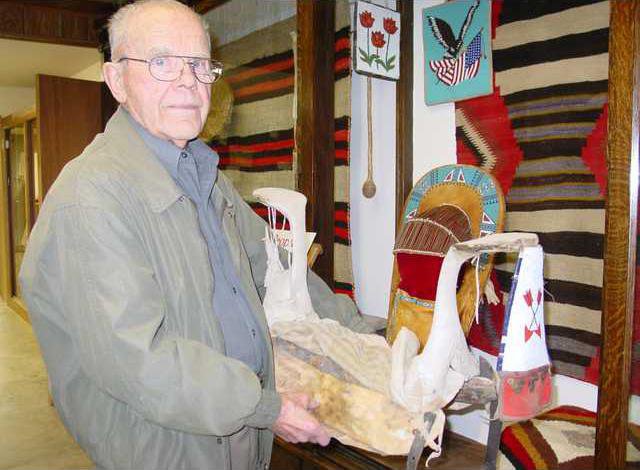Great Bend’s Robert Button, a longtime supporter of the Barton County Historical Society Museum and Village, has loaned the museum a collection of 30 native American Indian artifacts for a new exhibit. Navaho, Apache, Sioux and Anasazi are just a few of the tribes featured.
The exhibit is called "First Peoples," because that is what the American Indians called themselves, explains Beverly Komarek, executive director of the museum, located just south of the Arkansas River Bridge on South U.S. 281 in Great Bend. Starting this week, the museum will be open from 10 a.m. to 5 p.m. Tuesday through Friday, and 1-5 p.m. Saturdays and Sunday. It is closed Mondays. (Note the "winter" hours are still in effect until Tuesday, so the museum is closed today.) Admission is $4 for people 16 years of age and older who are not Historical Society members.
Button’s collection is certainly "museum quality," and Komarek said people don’t have to drive to Denver or Topeka to see an outstanding collection.
Button, who has been collecting American Indian artifacts since the 1970s, explained a few of the items in the display:
• Navaho "pound rug" from 1879 - "At one time, traders got to buying rugs by the pound. The Navahos got smart and started putting sand in them."
• Apache girl’s coming of age dress - This heavy garment appears to be made of deer or elk hide, with lots of fringe and decorative tin cones dangling from it. The dress was only worn once, for the three-day coming of age ceremony.
• Crow or Shoshone rawhide parfleche (a folding bag typically used to carry dried meats and pemmican) - "They would carry it like a suitcase."
• Anasazi storage pot - If a large clay pot was no longer suitable for cooking, it was sometimes buried in the floor around the edge inside a hogan and used for storage. It was covered with a flat rock.
Also on display are several of Button’s meticulous wood carvings, based on Swiss artist Karl Bodmer’s watercolor paintings from an expedition into the American West from 1832-34.
Button, a past president of the Historical Society’s board of directors, has also contributed to some of the museum’s permanent collection with a display from the Apache Chapter of the Kansas Anthropological Association. Excavations of the Fort Zarah area in the 1960s and ’70s yielded many arrowheads and other artifacts.
Komarek said the First Peoples exhibit is part of the museum’s year-long sesquicentennial observance — celebrating 150 years of Kansas statehood. In this case, the First Peoples is sort of a preface.
Karen Neuforth has contributed another new display: A time line of Kansas history from the 1820s to the present. There are many items packed into this display, even though it only takes up one corner in the museum. (One example: Look for a small wooden table with the words "Remembrance of Nov. 10, 1915 cyclone, Great Bend" painted on it.) It starts with trails, treaties and expansion from the 1820-1850s; move on to settlement and development of 1860-1890s; World Wars and Baby Booms, 1900-1960; and from "flower power" to the digital age, 1960 to present day. This display also has a buffalo skin that kids are invited to touch.
A small display of children’s toys from several eras is also new at the museum.
One exhibit that is "back up" is the wind energy display. Komarek said it’s especially fitting for the Kansas sesquicentennial, since the word "Kansas" is generally translated as "people of the south wind."





